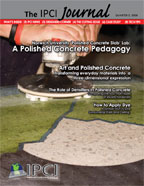A Polished Concrete Pedagogy
Polished Concrete Slab Project Broadens Young Minds
by Rebecca Miller
Assistant Professor Matthew Lutz of the Norwich University School of Architecture and Art is supporting the college’s lofty state mission of teaching students "The meaning of making and the making of meaning" through an original, polished concrete lab assignment in the sophomore-level Materials, Construction and Design class he teaches.
"At Norwich we believe architects are makers of things that point to a larger meaning…and as an accredited architecture school, we use a combined curriculum approved by the NAAB (National Architectural Accrediting Board) which calls for materials studies as part of the program," Lutz explains. To this end the Assistant Professor created the Polished Slab Project, an individual, semester-long task designed to teach students to search for the extraordinary in seemingly everyday building materials - like concrete. Lutz’s hands-on lab incited the kind of enthusiasm rarely found in a lecture hall. "The class was excited, really excited about the possibilities," he says. "My charge to them was to add something unique to the mixture…anything from changing the admixture to including glass beads, coloring, or recycled materials…the result was that ‘ahh-factor’ that is irreplaceable in the learning process."
"Before the Slab Project, the students generally believed cement and concrete were interchangeable terms and materials," says Lutz. By the end of the class, the project had not only taught them the difference, but had opened these future architects eyes to the power and visual impact a floor can have on the interior of a building. Much like the majority of the public, Matt’s students had never seen, or at least had never noticed, polished concrete as a flooring application. "Most people do not think of concrete as an indoor option." he comments, "…they learned first hand that concrete isn’t just for garages." Lutz concludes, "Drawing the students’ attention to detail was the best lesson that came out of this project."
Peter Abiles, a student who took the course, concurs, "I used to think of concrete as only the stuff of foundations...This project changed my mind. It’s one thing to learn about materials in a classroom via slideshow and entirely another to learn hands-on. It gave me a better perspective on possible uses." Abiles forecasts that his future projects will include polished concrete. "It’s a cool thing," Peter relates," and I like the look of it."
The guidelines and due dates of the Slab Project were looser than a standard MLA-formatted term paper; Matt was more concerned with individual creativity than a notebook full of instructions. "I didn’t want the students asking ‘what does the faculty want to see out of this’… I wanted them to think about their project and what it could be." He did, however, give clear instructions to the class: the slab was to be 10 x 17 with a 2.5 inch thickness, and the students were responsible for building the formwork, making a unique admixture, curing, and polishing the concrete to a 3,000 level [resin] grit. "…almost anything the students could come up with was OK, as long as the general requirements were met."
Lutz kicked off the assignment by showing the students close-up photos of concrete samples. "It’s important to show good examples up front," he advises, "because you have to set the standard… one picture even showed a glowing blue slab, which really got their attention and made them think about what concrete could be." The examples Matt showed were, he said, "to set up an almost unrealistically high level of expectation…to set up a goal."
"It was amazing how different each slab was…despite the same set of instructions every student ended up with a unique piece," says Lutz. In total there were 40 slabs presented in class.
Peter Abiles interesting concept was to create a "giant concrete magnet" by adding iron filings to the mixture. He reasoned people could use magnets to hang things on the concrete instead of drilling into it. "Once it was dried and polished it ended up looking like metal and the magnets stuck," Abiles says. "One girl used India ink, which turned out looking like marble…it was beautiful," says Peter, "and a guy included copper tubing, which turned out really shiny." Another enterprising green-minded student added ground-up tire fragments, thinking flooring could be a great place to recycle such refuse. Still others added topical dye treatments or glass components for an artsy finish. Peter says his classmates did a lot of cool, unexpected things with the slabs, and added that "it was really fun despite the hard work involved".
Assistant Professor Lutz "definitely recommends the Polished Slab Project to other teachers in the field," adding the advice to "think ahead of time about a way to display the slabs…at Norwich we are creating a permanent exhibit." He says this gives the students extra incentive to think creatively. University of Cincinnati School of Design, Art, Architecture and Planning student Craig Moyer, whose course curriculum does not currently include anything like the Slab Project, says he would like to do similar studio work because he would "benefit from alternative ideas and design solutions."

